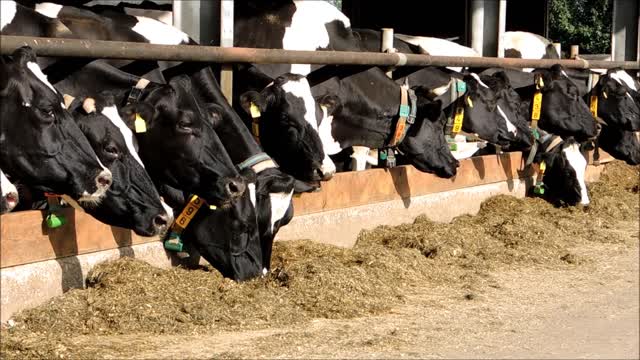Premium Only Content

Neck Numbered Cow In Stable Eating Grass
Neck Numbered Cow In Stable Eating Grass , Females, prior to giving birth are called calves or heifers. After they give birth, female dairy animals are called cows. All cows produce milk once they deliver a calf. Dairy cattle are milked two to three times a day. About 10 months after calving, the amount of milk the cow gives naturally decreases, and she begins to dry off, allowing her a rest period before giving birth. A cow will conceive again about two to four months after having a calf, meaning her next calf will be born about 12 to 14 months later, at which time she will rejoin the milking herd.
A dairy cow begins giving milk once she delivers her first calf at about two years of age. Dairy cows have a calf about once a year. Taking care of calves is important to dairy farmers because calves represent the future. When a cow is ready to give birth, the cow goes to a maternity area to ensure comfort and safety. Calves are usually moved to a calf hutch shortly after birth. This protects them from germs that can be passed from the environment or other animals while their immune systems mature. It also allows for individualized feeding and health monitoring.
Veterinarians routinely visit dairy farms to conduct check-ups, administer vaccinations and treat illness. Farmers and their workers observe the dairy cattle every day, so they quickly notice if an animal becomes ill. The veterinarian is called for a consultation if needed.
If a dairy cow becomes sick, she is often treated with antibiotics to help her recover. A dairy cow being treated with antibiotics is either separated from the milking herd or clearly identified so that her milk is not mixed with that of the healthy dairy cattle. This insures her milk does not enter the food supply until the antibiotics have cleared her system.
To ensure there are no antibiotic residues in the milk, the U.S. Food and Drug Administration (FDA) requires that every truckload of milk – organic and regular – is tested for commonly used antibiotics when it arrives at the dairy processing plant. Any milk that tests positive is rejected, and the farmer is financially responsible for the tanker of milk.
-
 LIVE
LIVE
BitLab Academy
2 hours agoAltcoins Ready!? Critical Bitcoin Signal! Crypto Signals Say This Is Next!
90 watching -
 59:52
59:52
VINCE
3 hours agoDoes This Move Mean Justice Is Finally Coming? | Episode 29 - 04/24/25
168K169 -
 29:06
29:06
Standpoint with Gabe Groisman
1 day agoIran’s Rise Under Joe Biden
13.4K2 -
 7:38
7:38
Dr David Jockers
1 day agoThe #1 Herb for Your Liver, Kidneys and Gut (Doctors Won't Prescribe This!)
218 -
 LIVE
LIVE
Bannons War Room
2 months agoWarRoom Live
17,889 watching -
 LIVE
LIVE
Discover Crypto
1 hour ago $0.51 earned$200K BITCOIN Happening: Nation-State ACCUMULATION Underway!
150 watching -
 2:37:20
2:37:20
Scammer Payback
20 hours agoCalling Scammers Live
10.6K -
 LIVE
LIVE
The Big Mig™
2 hours agoZelensky The Man With NO Cards To Play
4,583 watching -
 1:23:13
1:23:13
Dear America
3 hours agoUS Military IS BACK, Sees RECORD Numbers + Dem Rep. Calls For Outrageous Minimum Wage Increase!
74.5K26 -
 LIVE
LIVE
Badlands Media
4 hours agoBadlands Daily: April 24, 2025
4,880 watching